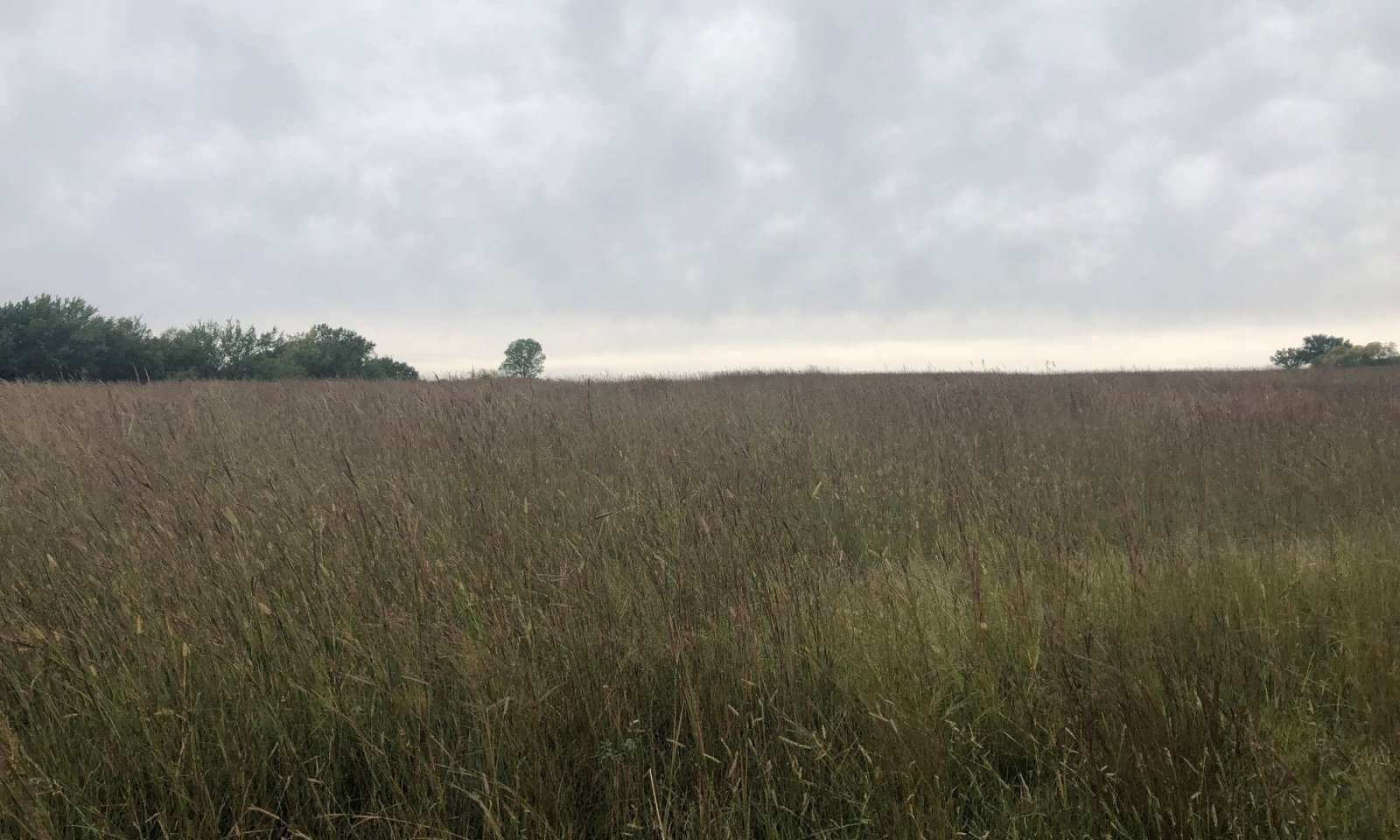

Natural Resources
Conservation Service
Ecological site R080AY056OK
Loamy Upland
Last updated: 9/19/2023
Accessed: 04/13/2025
General information
Provisional. A provisional ecological site description has undergone quality control and quality assurance review. It contains a working state and transition model and enough information to identify the ecological site.
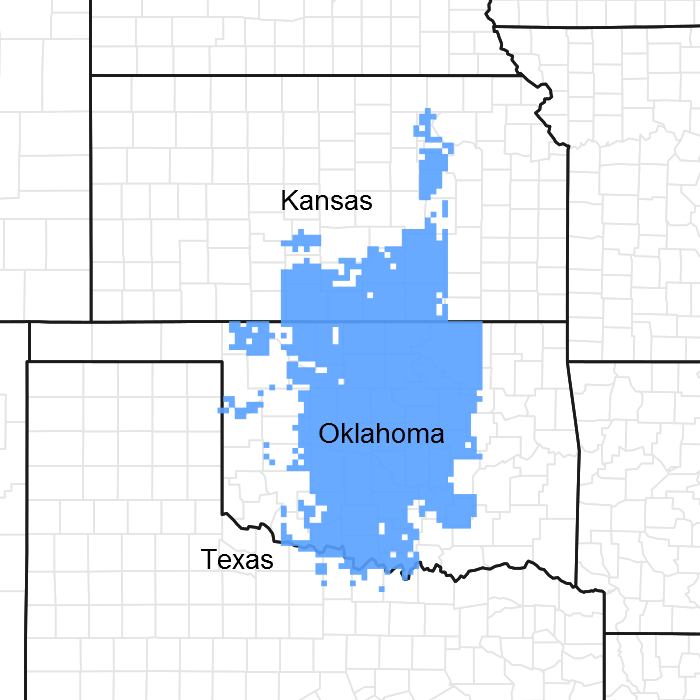
Figure 1. Mapped extent
Areas shown in blue indicate the maximum mapped extent of this ecological site. Other ecological sites likely occur within the highlighted areas. It is also possible for this ecological site to occur outside of highlighted areas if detailed soil survey has not been completed or recently updated.
MLRA notes
Major Land Resource Area (MLRA): 080A–Central Rolling Red Prairies
MLRA 80A is characterized by dark red Permian sandstones or shales that are exposed on gently sloping plains. The dominant soil order in this MLRA is Mollisols. The soils in the area dominantly have a thermic soil temperature regime, an ustic soil moisture regime, and mixed, siliceous, or smectitic mineralogy. They generally are shallow to very deep, are well drained, and generally are loamy or clayey. These plains are dissected by rivers that flow from northwest to southeast. Major rivers of this MLRA include the Chickaskia and Bluff rivers in KS, the Salt Fork, Cimarron, North and South Canadian, Washita, Cache, Red River in OK, and branches of the Wichita River in TX.
Classification relationships
This ecological site is correlated to soil components at the Major Land Resource Area (MLRA) level which is further described in USDA Ag Handbook 296.
Ecological site concept
The Loamy Upland ecological site is one of the most extensive sites within the MLRA. The site can be found over deep, loamy, mollisol soils on uplands. These soils have good water holding capacity and are a good source of groundwater recharge under reference conditions. The reference ecological state for this site has evolved through historical fires, drought, and periodic grazing events. It consists of native tallgrasses and forbs with a small amount of woody shrubs. If fire is removed from the system, woody species may encroach and eventually dominate the ecosystem processes. Eastern redcedar is one of the woody species that has invaded many of the Loamy Upland ecosites over the last century.
Additional land uses of this ecosite are described within this report. They include cropland and pastureland.
Associated sites
| R080AY011OK |
Claypan Upland (South) Similar landscapes. Restrictive subsurface claypan. Lower production. |
|---|---|
| R080AY010OK |
Claypan Upland (North) Similar landscapes. Restrictive subsurface claypan. Lower production. |
| R080AY073OK |
Sandy Loam Upland Coarser textured soils. Slightly lower production. |
Similar sites
| R080AY010OK |
Claypan Upland (North) Similar landscapes. Restrictive subsurface claypan. Lower production. |
|---|---|
| R080AY073OK |
Sandy Loam Upland Sandy loam soils on uplands |
Table 1. Dominant plant species
| Tree |
Not specified |
|---|---|
| Shrub |
(1) Amorpha canescens |
| Herbaceous |
(1) Andropogon gerardii |
Physiographic features
This site is an upland site on hills and paleoterraces. Slopes vary 0 to 20% but are typically less than 10%.
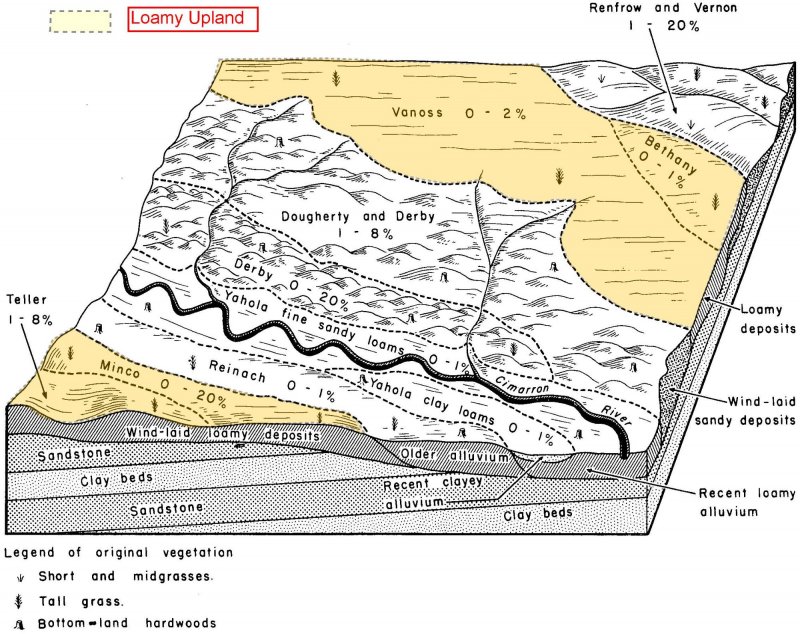
Figure 2.
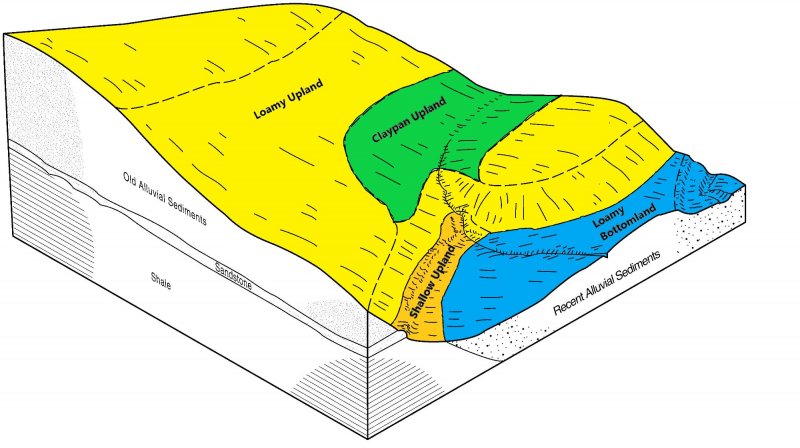
Figure 3.
Table 2. Representative physiographic features
| Landforms |
(1)
Plains
> Hill
(2) Plains > Paleoterrace |
|---|---|
| Runoff class | Negligible to high |
| Elevation | 213 – 457 m |
| Slope | 1 – 10% |
| Water table depth | 152 cm |
| Aspect | Aspect is not a significant factor |
Climatic features
The climate is characterized by moist, cool, springs; hot, often dry summers; mild autumns; and mild to cold winters. Variation in timing and amounts of precipition from year to year is quite common. Drought cycles range from three to five years duration with occasionally longer periods occurring at unpredictable intervals. Above normal rainfall cycles are usually just as random, but shorter in duration.
Table 3. Representative climatic features
| Frost-free period (characteristic range) | 173-187 days |
|---|---|
| Freeze-free period (characteristic range) | 194-203 days |
| Precipitation total (characteristic range) | 838-940 mm |
| Frost-free period (actual range) | 157-192 days |
| Freeze-free period (actual range) | 191-208 days |
| Precipitation total (actual range) | 813-991 mm |
| Frost-free period (average) | 179 days |
| Freeze-free period (average) | 199 days |
| Precipitation total (average) | 889 mm |
Figure 4. Monthly precipitation range
Figure 5. Monthly minimum temperature range
Figure 6. Monthly maximum temperature range
Figure 7. Monthly average minimum and maximum temperature
Figure 8. Annual precipitation pattern
Figure 9. Annual average temperature pattern
Climate stations used
-
(1) WATONGA [USC00349364], Watonga, OK
-
(2) PAULS VALLEY 4 WSW [USC00346926], Pauls Valley, OK
-
(3) ANTHONY [USW00013980], Anthony, KS
-
(4) STILLWATER 5 WNW [USW00053927], Stillwater, OK
-
(5) OKEENE [USC00346629], Okeene, OK
-
(6) WALTERS [USC00349278], Walters, OK
-
(7) KINGFISHER [USC00344861], Kingfisher, OK
-
(8) JEFFERSON [USC00344573], Medford, OK
-
(9) CHEROKEE 4W [USC00341724], Cherokee, OK
Influencing water features
These sites occur in upland positions that are not subject to flooding or wetland influences.
Wetland description
N/A
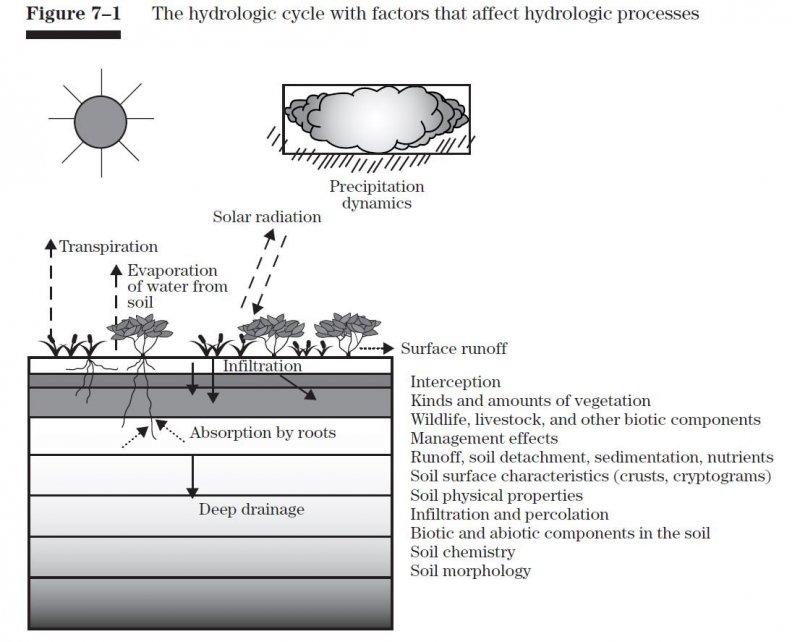
Figure 10.
Soil features
Soils are mapped for each county within the MLRA. Mapunits are representations of the major soil series component(s) and named accordingly. Each Mapunit is spatially represented on a digital soils map as polygons of different shapes and sizes. Within these Mapunits, there are often minor soil series components included. These minor components are soils that occur within a Mapunit polygon but are of small extent (15% or less of the Mapunit area). However, it is difficult to separate these minor soils spatially due to the scale of soil mapping.
Ecological sites are correlated at the component level of the soil survey. Therefore, a single Mapunit may contain multiple ecological sites just as it may contain multiple soil components. This is important to understand when investigating soils and ecological sites. A soil survey Mapunit may be correlated to a single ecological site based on the major component; however, there may be inclusional areas of additional Ecological Sites which are correlated to the minor components of that particular soil Mapunit.
Representative soil components for this site include:
Coyle, Zaneis, Grant, Pond Creek, and Teller
Soils on this site are deep well-drained loams. Under the reference plant community, these soils have good water infiltration and high water holding capacity within the root zones. However, the soils are susceptible to water erosion when not protected.
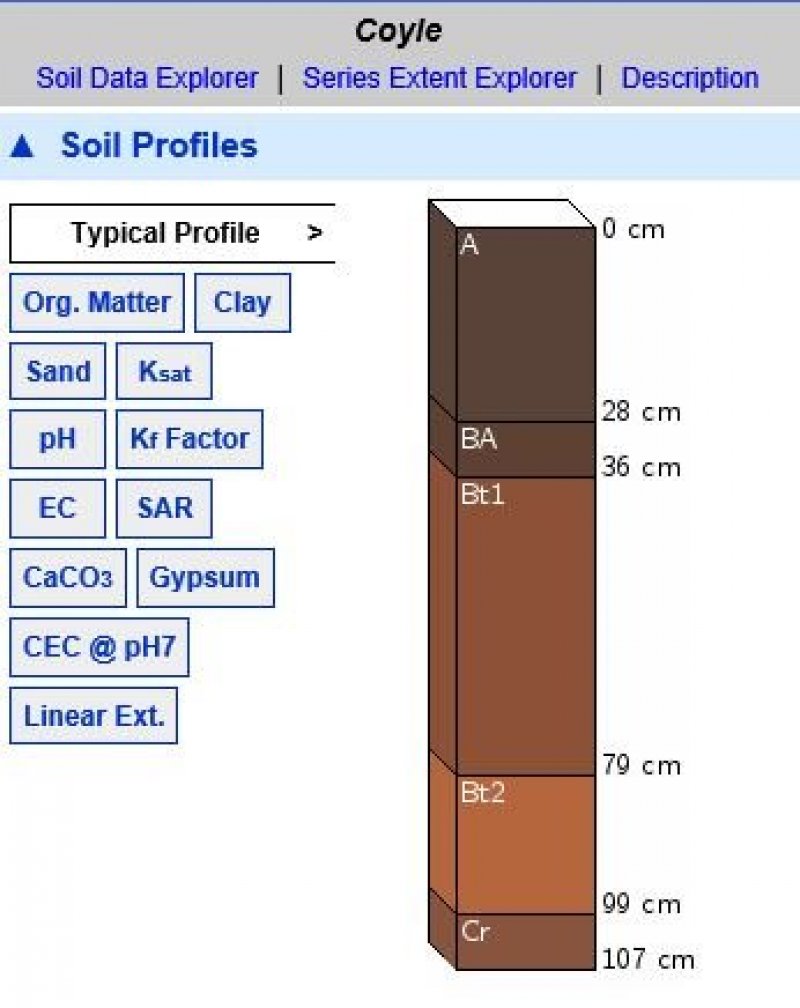
Figure 11. Typical Profile of Coyle Loam
Table 4. Representative soil features
| Parent material |
(1)
Residuum
–
sandstone and shale
|
|---|---|
| Surface texture |
(1) Loam (2) Silt loam (3) Very fine sandy loam |
| Drainage class | Moderately well drained to well drained |
| Permeability class | Moderately slow to moderate |
| Soil depth | 102 – 203 cm |
| Surface fragment cover <=3" | 0 – 2% |
| Surface fragment cover >3" | 0 – 2% |
| Available water capacity (0-101.6cm) |
12.7 – 27.94 cm |
| Soil reaction (1:1 water) (0-101.6cm) |
5.5 – 7.3 |
| Subsurface fragment volume <=3" (Depth not specified) |
0 – 24% |
| Subsurface fragment volume >3" (Depth not specified) |
0 – 22% |
Ecological dynamics
Like many sites across the Great Plains, this site evolved under periodic disturbances by fire, drought, and grazing(Frost 1998,Fuhlendorf 2009). The soils are well suited for herbaceous plant growth. The reference state of this site is very resilient to natural disturbances. Alternative land uses include cropland and pastureland. Alternative states within the rangeland land use include a woody encroached state, a reseeded state and an eroded state.
The reference state for this ecological site is a stable grassland. This state is dominated by native warm season grasses and perennial forbs. Woody species are present in sparse amounts throughout the reference state. Evolution of the plant community has historically been driven by the periodic disturbances of grazing and wildfire that have limited the encroachment and spread of woody species.
When fire suppression occurs, the state may shift toward a tree or shrub dominated state. When woody shrubs begin to dominate the state, they outcompete grasses for moisture, sunlight, and nutrients. While chemical or mechanical brush management can help mitigate brush encroachment, there is no substitute for fires occurring at regular intervals.
Historically, the focus of conservation efforts has been on proper stocking rates and restoration of the woody encroached sites across the Great Plains. However, new research suggests that a more effective strategy involves addressing woody plants in the seed dispersal stage prior to the change in ecological states. Preserving intact prairie for both agricultural production and ecosystem services must become a priority for land managers and conservationist alike.
Many loamy upland ecological sites were once farmed or are currently in production. Some have been abandoned to volunteer species while others have been reseeded to native or introduced species. Evidence of surface erosion could be prevalent across these sites depending on the crop in production, slope, farming practices, and time in cultivation. Many farmed sites have transitioned to the eroded state of this ecological site.
State and Transition Diagram:
A State and Transition Diagram for the Loamy Upland (R080AY056OK) site is depicted below. Thorough descriptions of each state, transition, and pathway follow the model. Experts base this model on available experimental research, field observations, professional consensus, and interpretations. It is likely to change as knowledge increases.
Plant communities will differ across the MLRA because of the natural variability in weather, soils, and aspect. The Reference ecological state may not necessarily be the management goal; other vegetative states or land uses may be desired.
The biological processes on this site are complex. Therefore, representative values are presented in a land management context. The species lists are representative and are not botanical descriptions of all species occurring, or potentially occurring, on this site. They are not intended to cover every situation or the full range of conditions, species, and responses for the site.
State and transition model
More interactive model formats are also available.
View Interactive Models
Click on state and transition labels to scroll to the respective text
Land use 1 submodel, ecosystem states
State 1 submodel, plant communities
Land use 2 submodel, ecosystem states
Land use 3 submodel, ecosystem states
Land use 1
Rangeland
This land use is predominately used for grazingland or recreational use. This land use often requires fewer or less intensive inputs than other land use types. The rangeland land use includes both reference, unplowed rangeland as well as land that has been reseeded or repopulated to native species post-cultivation.
State 1.1
Grassland (Reference)
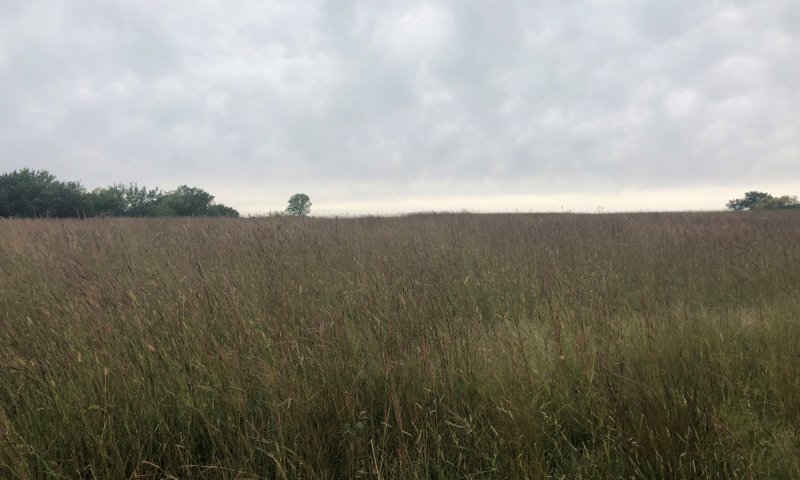
The grassland state is the reference ecological state for the Loamy Upland ecosite. This state represents the historical range of variability across the ecological site as it evolved with fire, grazing, and drought interactions.
Characteristics and indicators. This state is dominated by warm season, perennial grasses which drive energy flow and hydrology on the site. Forbs and legumes are common, along with few scattered woody shrubs(<10% canopy). This state is at risk of woody encroachment by eastern redcedar in all community phases if fire is removed from the site.
Resilience management. Under periodic disturbance by managed grazing and prescribed fire, this state can be very resilient to environmental stressors. Drought and wildfire are recovered from relatively quickly if at or near reference conditions.
Dominant plant species
-
leadplant (Amorpha canescens), shrub
-
big bluestem (Andropogon gerardii), grass
-
Indiangrass (Sorghastrum nutans), grass
Community 1.1.1
Tallgrass Prairie


Figure 12. Loamy Upland 1.1
This community is an open tallgrass community dominated by big bluestem, sand bluestem, Indiangrass, little bluestem and switchgrass. The major midgrasses and shortgrasses are sideoats grama, meadow dropseed and Scribner’s panicum. This site also supports a variety of forbs and legumes including catclaw sensitivebrier, leadplant, wild indigo, heath aster, Englemann's daisy, Maximillian sunflower, ashy sunflower, dotted gayfeather, western ragweed, Louisiana sagewort, Illinois bundleflower, pitchers sage, and others. Scattered prickly pear cactus, and soapweed yucca may be found on this site. This plant community has evolved through the collective influence of extremes in temperature, rain, wind, drought, fire, and seasonal herbivory by large ungulates, primarily bison. Abusive grazing, which exceeds carrying capacity decreases the more palatable grasses such as big bluestem, indiangrass and switchgrass as well as palatable forbs and legumes. Under this scenario, little bluestem, silver bluestem, prairie threeawn, other annual and perennial grasses, and forbs will usually increase. The rate at which this occurs is dependent upon stocking rate, rest periods and climatic patterns. The absence of grazing, the absence of fire, or both may result in litter buildup and stagnation of ecological functions.
Figure 13. Annual production by plant type (representative values) or group (midpoint values)
Table 5. Annual production by plant type
| Plant type | Low (kg/hectare) |
Representative value (kg/hectare) |
High (kg/hectare) |
|---|---|---|---|
| Grass/Grasslike | 2522 | 4739 | 6053 |
| Forb | 196 | 370 | 471 |
| Shrub/Vine | 56 | 106 | 135 |
| Tree | 28 | 53 | 67 |
| Total | 2802 | 5268 | 6726 |
Figure 14. Plant community growth curve (percent production by month). OK0009, Native Warm-Season Grasses. The growing season for warm season(C4) grasses in this region runs from last frost to first frost with peak production from mid April through mid July. The curve listed below is intended to be a representative of normal growing conditions. The monthly production pecentages can vary from year to year deopending upon temperature and rainfall variatioins..
| Jan | Feb | Mar | Apr | May | Jun | Jul | Aug | Sep | Oct | Nov | Dec |
|---|---|---|---|---|---|---|---|---|---|---|---|
| J | F | M | A | M | J | J | A | S | O | N | D |
| 0 | 0 | 3 | 9 | 25 | 28 | 15 | 5 | 10 | 5 | 0 | 0 |
Community 1.1.2
Little Bluestem Dominant

Figure 15. Little Bluestem Dominant
This plant community is dominated by little bluestem that makes up approximately 60 to 75 percent of the total annual vegetative production of the site. Other important grasses are big bluestem, sand bluestem, Indiangrass, switchgrass, sideoats grama and blue grama. This site also supports a variety of forbs and legumes including catclaw sensitivebrier, heath aster, dotted gayfeather and western ragweed.
Resilience management. With managed grazing and prescribed fire, this community can be quite resilient to short term disturbances. Like any community in the reference state, it is at risk of Juniper encroachment if prescribed fire is not used.
Figure 16. Plant community growth curve (percent production by month). OK0001, Native, Warm Season Grasses. Typically, the summer growing season for warm season grasses begins April 5 to 15 and ends October 15 to 25. Nearly three-fourths of the season production will occur before the first of July. This varies from year to year depending upon temperatures and precipitation..
| Jan | Feb | Mar | Apr | May | Jun | Jul | Aug | Sep | Oct | Nov | Dec |
|---|---|---|---|---|---|---|---|---|---|---|---|
| J | F | M | A | M | J | J | A | S | O | N | D |
| 0 | 1 | 5 | 10 | 20 | 30 | 10 | 5 | 10 | 6 | 2 | 1 |
Community 1.1.3
Midgrass/Shortgrass Dominant
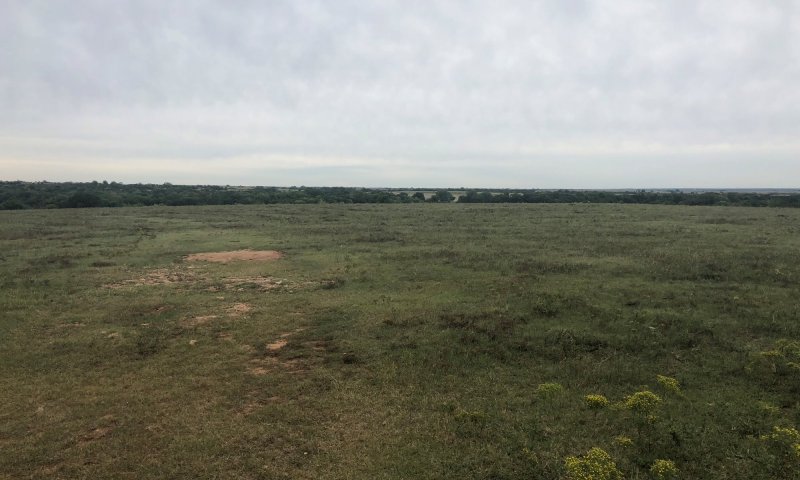
This community consists of silver bluestem, sideoats grama, dropseeds, blue grama, buffalograss and a small percentage of other perennial grasses such as little bluestem, Indiangrass, switchgrass and hairy grama. Western ragweed and prairie threeawn may also make up a significant portion of the annual production. Numerous forbs such as Louisiana sagewort, heath aster, wavyleaf thistle and common yarrow are on this site. Common broomweed and bitter sneezeweed may increase also. This plant community is usually the result of multiple abusive grazing events.
Resilience management. This community can be quite resilient if measures are taken to prevent Juniper encroachment. Also, as bare ground increases, risk of soil loss by erosion events increases.
Figure 17. Plant community growth curve (percent production by month). OK0001, Native, Warm Season Grasses. Typically, the summer growing season for warm season grasses begins April 5 to 15 and ends October 15 to 25. Nearly three-fourths of the season production will occur before the first of July. This varies from year to year depending upon temperatures and precipitation..
| Jan | Feb | Mar | Apr | May | Jun | Jul | Aug | Sep | Oct | Nov | Dec |
|---|---|---|---|---|---|---|---|---|---|---|---|
| J | F | M | A | M | J | J | A | S | O | N | D |
| 0 | 1 | 5 | 10 | 20 | 30 | 10 | 5 | 10 | 6 | 2 | 1 |
Pathway 1.1A
Community 1.1.1 to 1.1.2


Through heavy grazing that exceeds carrying capacity, this plant community may diverge to community phase 1.2 Little Bluestem Dominant. This may also occur under moderate grazing during periods of long term drought.
Conservation practices
| Prescribed Burning | |
|---|---|
| Prescribed Grazing |
Pathway 1.2A
Community 1.1.2 to 1.1.1


Through an established prescribed grazing program with proper stocking rates, periodic rest, and adequate soil moisture, this community phase may be restored to community 1.1.
Conservation practices
| Prescribed Burning | |
|---|---|
| Prescribed Grazing | |
| Prescribed Grazing |
Pathway 1.2B
Community 1.1.2 to 1.1.3


If carrying capacity is exceeded for an extended period of time, the plant community may shift to one that is dominated by less desirable midgrass species (1.3 Midgrass Dominant Community). Witthout the use of prescribed fire, woody species may begin to encroach this plant community.
Conservation practices
| Prescribed Burning | |
|---|---|
| Prescribed Grazing |
Pathway 1.3A
Community 1.1.3 to 1.1.2


Through the establishment of a prescribed grazing program that includes extended periods of deferment or "rest" from grazing, this community phase may be reverted to community 1.2. With the accumulation of fine fuels through grazing deferment, a prescribed fire program may be implemented to address any encroaching woody species.
Conservation practices
| Prescribed Burning | |
|---|---|
| Prescribed Grazing | |
| Prescribed Grazing |
State 1.2
Woody

In the woody state, eastern redcedar dominate ecological functions. Grasses such as little bluestem, sideoats grama, blue grama, hairy grama, silver bluestem, buffalograss and prairie threeawn are still present. Western ragweed, prickly pear cactus, common broomweed, wavyleaf thistle, and other forbs are abundant. Some tallgrasses may persist in the interspaces depending on grazing pressure. Hydrology has been altered through increased evapotranspiration as well as increased rainfall interception by the woody canopy. When this state occurs, significant inputs of chemical or mechanical brush control must be utilized to remove woody species.
Characteristics and indicators. This state is characterized by woody canopy(primarily juniper) exceeding 30 percent.
Resilience management. This state can be quite resilient. Other than the increased risk of wildfire, the dominant juniper can withstand climatic fluctuations and grazing events.
Dominant plant species
-
eastern redcedar (Juniperus virginiana), tree
-
sumac (Rhus), shrub
-
silver beardgrass (Bothriochloa laguroides), grass
State 1.3
Reseeded
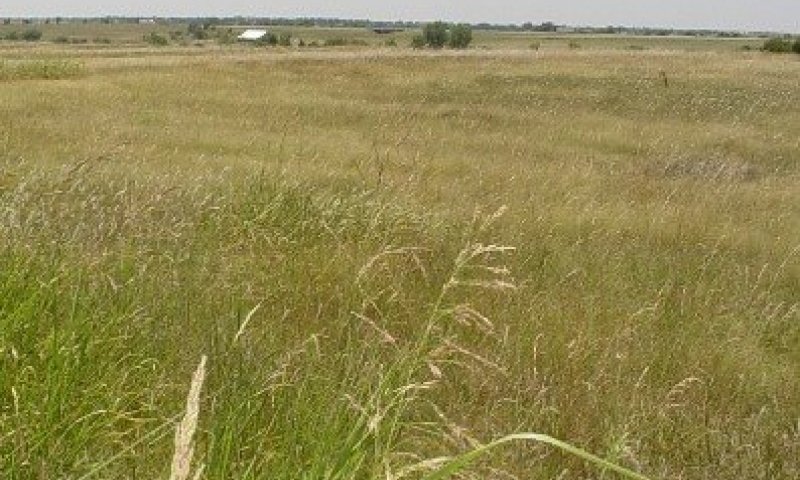
This ecological state is the result of reseeding or allowing a site to "go back" to native species after a period of cultivation. This state may also occur if the introduced forages in the pasture state are no longer managed and native plants begin to repopulate. This state is the result of a land use conversion from rangeland to cropland and back to rangeland.
Characteristics and indicators. This state is characterized by native and non-native plant communities on previously cultivated land. These communities typically have lower diversity than the reference state and soil properties may still be significantly altered.
Resilience management. Will most communities are quite resilient, those within this state may be more susceptible to ground disturbing activities and drought periods due to the altered soil structure.
Dominant plant species
-
little bluestem (Schizachyrium scoparium), grass
State 1.4
Eroded
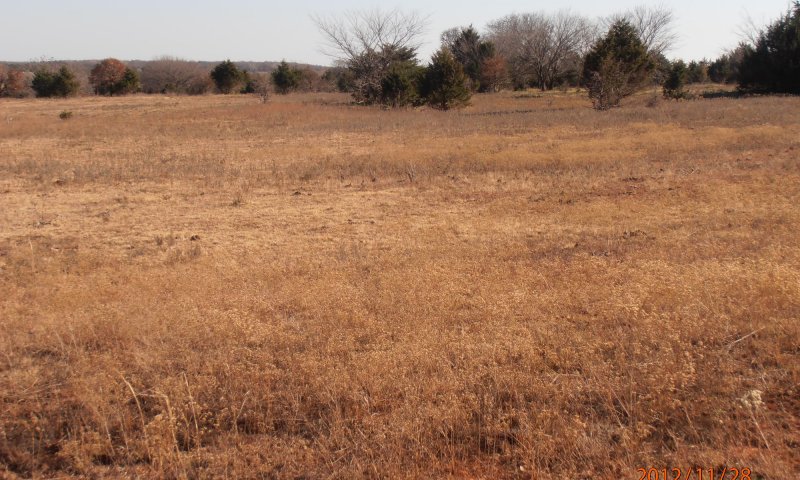
This state is the result of water erosion over bare soil. Most of the "A" horizon of the soil profile has been displaced. The remaining subsoil is very low in fertility. Some native grasses and forbs will persist in this state, however, production is greatly reduced. This state is the result of a land use conversion from rangeland to cropland and back to rangeland. Plant production and composition is highly variable within this state depending on prior disturbance and degree of soil loss. On site investigations are required to determine the level of productivity.
Dominant plant species
-
silver beardgrass (Bothriochloa laguroides), grass
-
threeawn (Aristida), grass
Transition T1A
State 1.1 to 1.2


With the removal of fire, woody species may increase across the site. Eastern redcedar, a native woody plant, was historically restricted across these sites due to frequent fires. Being an aggressive evergreen tree, they can quickly outcompete the herbaceous plants for water, nutrients and sunlight leading to a transition towards the woody state.
Constraints to recovery. Degree of encroachment by woody species is a major factor in determining restoration strategies. A thorough inventory of woody encroachment should be completed.
Transition T1B
State 1.1 to 1.3


This transition is the result of a land use conversion from rangeland to cropland and then back to rangeland (see land use model). Often this is facilitated by the end of cultivation and reseeding to a range mix.
Constraints to recovery. As a result of cultivation, soil properties are altered and ecological processes are changed. While permanent native vegetation can be re-established to a species mix similar to the reference state, often the site may never be restored ecologically to reference condition.
Transition T1C
State 1.1 to 1.4


This transition is the result of a land use conversion from rangeland to cropland, experiencing severe water erosion events, and then back to rangeland (see land use model). Often this is facilitated by the end of cultivation and reseeding to a range mix.
Constraints to recovery. As a result of cultivation and soil erosion, soil properties are altered and ecological processes are changed. While permanent native vegetation can be re-established to a species mix similar to the reference state, often the site may never be restored ecologically to reference condition. This is especially true of sites that have experience a significant loss of the soil surface horizon.
Restoration pathway R2A
State 1.2 to 1.1


Mechanical brush management may be required depending on size of trees and available resources. Prescribed fire may be used if there is sufficient fine fuel continuity and adequate resources to safely conduct the burn. Grazing management prior to burn is vital for implementing a prescribed burn. Grazing management after the burn or mechanical treatment should include some period of rest to allow the herbaceous plant community adequately recover.
Conservation practices
| Brush Management | |
|---|---|
| Prescribed Burning | |
| Firebreak | |
| Prescribed Grazing |
Land use 2
Cropland
The site has been cultivated for the production of crops. Primary use is agronomic crop production.
Community 2.1
Conventional Till
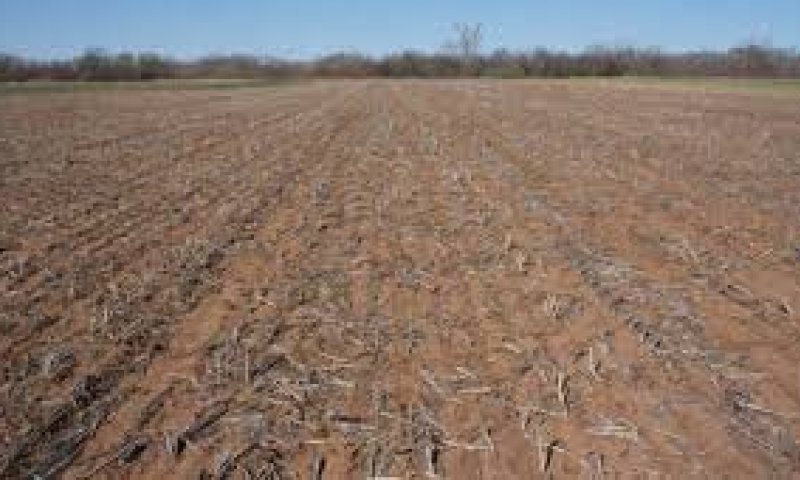
This community represent a conventional tillage system where subsequent crops are planted into a clean tilled seedbed. Crop rotations may also be used in this production system, however, the field are consistently plowed between plantings. Perennial cultivation can lead to accelerated soil loss from water and wind erosion. Proper planning is essential to ensure soil and water conservation in this system.
Dominant plant species
-
wheat (Triticum), grass
-
soybean (Glycine max), other herbaceous
Community 2.2
No Till
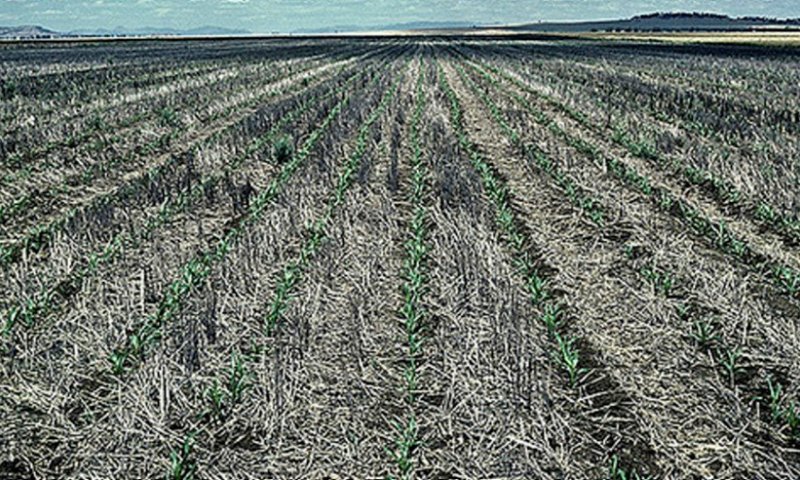
This community represents a no-till management system where subsequent crops are planted directly through residue remaining in the field. Crop rotations are often used in this system and, over time, this system may result in increased soil aggregation and increase organic matter. A no-till system may also help mitigate soil erosion.
Dominant plant species
-
wheat (Triticum), grass
-
soybean (Glycine max), other herbaceous
Land use 3
Pastureland
The site has been replanted to introduced forage grasses after cultivation ceased. Primary use is livestock and/or hay production. Often, this land use is managed as a monoculture with little biotic diversity. However, in some cases, forb/legume/grass mixtures are maintained with may increase soil and ecosystem health.
Community 3.1
Introduced grass monoculture
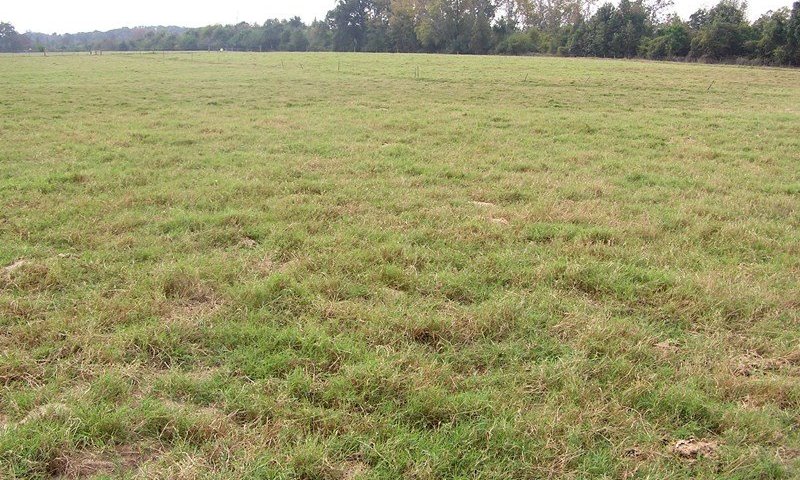
This community consists of a planted monoculture of an introduced pasture grass used predominately for grazing and/or hay production. Adapted species include bermudagrass, old world bluestems, and weeping lovegrass (only on well drained sites). These species require a higher level of management inputs than native rangeland species. Soil tests should be performed prior to planting and or subsequent fertilizer applications. Without persistent nutrient management and proper grazing, some undesired "weedy" species may invade the site. While biodiversity can be beneficial to both plants, animals, and soil, it may be undesirable under certain management systems such as certified hay production. Proper grazing should be planned to allow for adequate residual heights in order to ensure the vigor of the grass. These heights vary by species and grazing system. They can be found in the OK NRCS Prescribed Grazing practice specification. Average yields are listed below as representative for the MLRA. These yields can vary greatly depending on precipitation amount and timing. As with any pasture management program, site specific evaluation and monitoring is essential. Yields are represented AUMs or Animal Unit Months. This represents the amount of dry matter required by one Animal Unit Equivalent for one month. For more on AUEs and AUMs consult local extension service fact sheets and publications. Keep in mind these yields are estimated under a high level of management which includes annual additions of nitrogen and other nutrients as required. Bermudagrass: 3.5 - 6.0 AUMs Old World Bluestem: 3.5 - 6.0 AUMs Weeping Lovegrass: 3.5 - 5.5 AUMs It is important to note that while these introduced species can provide good grazing potential, often wildlife habitat is limited. These species are also known to expand offsite and become invasive in adjacent native ecosystems.
Dominant plant species
-
Bermudagrass (Cynodon dactylon), grass
Community 3.2
Grass/Legume mix
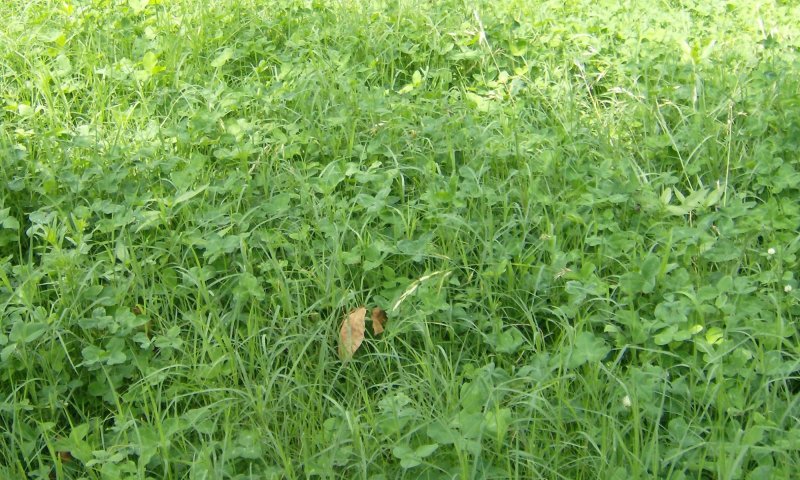
This community represents a planted mixture of introduced grasses and forbs/legumes. Bermudagrass and introduced clover is the most common pasture mix. Incorporation of a legume into the system can help offset inputs associated with nitrogen additions. Special strategies should be used to ensure the health and vigor of both the cool season legumes and warm season grasses. Yields for these pasture mixes are not available as the mixtures and ratios vary from site to site so yields for a monoculture community should be used as a baseline estimate.
Dominant plant species
-
Bermudagrass (Cynodon dactylon), grass
-
clover (Trifolium), other herbaceous
Pathway P
Community 3.1 to 3.2


Pathway P
Community 3.2 to 3.1


Conversion C
Land use 1 to 2
This land use conversion is the result of cultivation and planting of crops. Ecological processes are altered and the land is converted to an input based management system.
Conversion C
Land use 2 to 1
This land use conversion is achieved through reseeding native grasses and forbs in order to restore the site for livestock grazing or hay production. While the site may be converted back to a rangeland land use, some soil properties and ecological function may not return to pre-cultivation levels.
Conversion C
Land use 2 to 3
This land use conversion is the result of planting a perennial, introduced pasture grass. While still reliant on management inputs, grazing livestock or hay production is the primary objective of this land use.
Conversion C
Land use 3 to 1
This land use conversion is achieved through reseeding native grasses and forbs or allowing native species to repopulate the site by reducing management of introduced species. While the site may be converted back to a rangeland land use, some soil properties and ecological function may not return to pre-cultivation levels.
Additional community tables
Table 6. Community 1.1 plant community composition
| Group | Common name | Symbol | Scientific name | Annual production (kg/hectare) | Foliar cover (%) | |
|---|---|---|---|---|---|---|
|
Grass/Grasslike
|
||||||
| 1 | 2354–5716 | |||||
| little bluestem | SCSC | Schizachyrium scoparium | 708–1699 | – | ||
| Indiangrass | SONU2 | Sorghastrum nutans | 708–1699 | – | ||
| switchgrass | PAVI2 | Panicum virgatum | 412–991 | – | ||
| big bluestem | ANGE | Andropogon gerardii | 280–673 | – | ||
| sand bluestem | ANHA | Andropogon hallii | 280–673 | – | ||
| eastern gamagrass | TRDA3 | Tripsacum dactyloides | 21–49 | – | ||
| 2 | 27–64 | |||||
| Heller's rosette grass | DIOL | Dichanthelium oligosanthes | 9–21 | – | ||
| Canada wildrye | ELCA4 | Elymus canadensis | 9–21 | – | ||
| 3 | 29–72 | |||||
| sideoats grama | BOCU | Bouteloua curtipendula | 15–36 | – | ||
| rough dropseed | SPCL | Sporobolus clandestinus | 15–36 | – | ||
| 4 | 56–135 | |||||
| prairie threeawn | AROL | Aristida oligantha | 28–67 | – | ||
| silver bluestem | BOSA | Bothriochloa saccharoides | 28–67 | – | ||
|
Forb
|
||||||
| 5 | 24–71 | |||||
| white wild indigo | BAAL | Baptisia alba | 10–24 | – | ||
| Illinois bundleflower | DEIL | Desmanthus illinoensis | 10–24 | – | ||
| littleleaf sensitive-briar | MIMI22 | Mimosa microphylla | 10–24 | – | ||
| 6 | 166–399 | |||||
| common yarrow | ACMI2 | Achillea millefolium | 18–45 | – | ||
| Cuman ragweed | AMPS | Ambrosia psilostachya | 18–45 | – | ||
| white sagebrush | ARLU | Artemisia ludoviciana | 18–45 | – | ||
| Engelmann's daisy | ENPE4 | Engelmannia peristenia | 18–45 | – | ||
| common sunflower | HEAN3 | Helianthus annuus | 45 | – | ||
| Maximilian sunflower | HEMA2 | Helianthus maximiliani | 18–45 | – | ||
| whitest evening primrose | OEAL | Oenothera albicaulis | 18–45 | – | ||
| azure blue sage | SAAZ | Salvia azurea | 18–45 | – | ||
| white heath aster | SYER | Symphyotrichum ericoides | 18–45 | – | ||
|
Shrub/Vine
|
||||||
| 7 | 56–136 | |||||
| leadplant | AMCA6 | Amorpha canescens | 9–22 | – | ||
| roughleaf dogwood | CODR | Cornus drummondii | 0–22 | – | ||
| twistspine pricklypear | OPMA2 | Opuntia macrorhiza | 0–22 | – | ||
| Chickasaw plum | PRAN3 | Prunus angustifolia | 0–22 | – | ||
| smooth sumac | RHGL | Rhus glabra | 0–22 | – | ||
| coralberry | SYOR | Symphoricarpos orbiculatus | 0–22 | – | ||
| soapweed yucca | YUGL | Yucca glauca | 0–22 | – | ||
|
Tree
|
||||||
| 8 | 30–73 | |||||
Interpretations
Animal community
Domestic livestock and white-tail deer are the dominant grazers and browsers of the site. Various songbirds and small mammals may also find use of these areas. As the site changes towards the woody dominated community, the quality of the habitat may improve for some species and decline for others. Management must be applied to maintain a vegetative state in optimum habitat quality for the desired animal species.
Hydrological functions
These sites occur on uplands and shed water to adjacent sites lower on the landscape. The presence of deep rooted tallgrasses can help facilitate percolation of water into the soil profile. Minimizing bare ground is very important in reducing soil erosion by water movement. Post-cultivation, the soil structure has been significantly altered and may take many years to mitigate any plowpan or compaction that restricts water movement.
Recreational uses
Camping, fishing, hunting, hiking, bird watching, horseback riding and many other outdoor recreational practices.
Wood products
N/A
Other products
N/A
Other information
N/A
Supporting information
Inventory data references
The original information presented here was derived from Soil Conservation Service field observations of trained range personnel as well as clipping data done in Oklahoma from 1959 to 1971 by the following SCS Personnel: Clarence Kingery, Fred Whittington, Chester Fry, Paul Copeland, Phillip Hager, Curtis Smith, Chuck Grimes, Gerald Duke, Dale Stidham, Joe Cullen, Jim McCampbell, Robert Maples, and John Pewthers.
Numerous range clipping SCS-417 records are on file at Stillwater, OK state office and available as vegplot records in NASIS.
Type locality
| Location 1: Payne County, OK | |
|---|---|
| Township/Range/Section | T18N R1E SSW5 |
| General legal description | OSURR SW5-T18N-R1E |
References
-
Bestelmeyer, B., J.R. Brown, K.M. Havstad, B. Alexander, G. Chavez, and J.E. Herrick. 2003. Development and Use of State and Transition Models for Rangelands. Jornal of Range Management 56:114–126.
-
Frost, C.C. 1998. Presettlement Fire Frequency Regimes of the United States: A First Approximation. Plant Conservation Program. North Carolina Department of Agriculture and Consumer Services, Raleigh, NC.
Other references
Fuhlendorf, S. D., Engle, D. M., Kerby, J. A. Y., & Hamilton, R. (2009). Pyric herbivory: rewilding landscapes through the recoupling of fire and grazing. Conservation Biology, 23(3), 588-598.
Harlan, J. R. (1957). Grasslands of Oklahoma.
National Soil Information System (NASIS). Accessed 2013
Shantz, H. L. (1923). The natural vegetation of the Great Plains region. Annals of the Association of American Geographers, 13(2), 81-107.
Shiflet, T. N. (1994). Rangeland cover types of the United States (Vol. 152). Denver, CO, USA: Society for Range Management.
Contributors
Edits by Colin Walden, Soil Survey Office, Stillwater, OK
Dr. Jack Eckroat, Grazing Lands Specialist, NRCS, Oklahoma
John O. Pewthers
Approval
Bryan Christensen, 9/19/2023
Acknowledgments
Site Development and Testing Plan
Future work, as described in a Project Plan, to validate the information in this Provisional Ecological Site Description is needed. This will include field activities to collect low, medium and high intensity sampling, soil correlations, and analysis of that data. Annual field reviews should be done by soil scientists and vegetation specialists. A final field review, peer review, quality control, and quality assurance reviews of the ESD will be needed to produce the final document. Annual reviews of the Project Plan are to be conducted by the Ecological Site Technical Team.
Rangeland health reference sheet
Interpreting Indicators of Rangeland Health is a qualitative assessment protocol used to determine ecosystem condition based on benchmark characteristics described in the Reference Sheet. A suite of 17 (or more) indicators are typically considered in an assessment. The ecological site(s) representative of an assessment location must be known prior to applying the protocol and must be verified based on soils and climate. Current plant community cannot be used to identify the ecological site.
| Author(s)/participant(s) | Mark Moseley, Harry Fritzler, Steve Glasgow, Jack Eckroat, (C Walden edits) |
|---|---|
| Contact for lead author | |
| Date | 04/01/2005 |
| Approved by | Bryan Christensen |
| Approval date | |
| Composition (Indicators 10 and 12) based on | Annual Production |
Indicators
-
Number and extent of rills:
There are few, if any, rills and there is no active headcutting and sides are covered with vegetation. -
Presence of water flow patterns:
There is little, if any, evidence of soil deposition or erosion (some possibly apparent after significant rain events). Water generally flows evenly over the entire landscape. -
Number and height of erosional pedestals or terracettes:
There should not be any evidence of erosional pedestals or terracettes on this site. -
Bare ground from Ecological Site Description or other studies (rock, litter, lichen, moss, plant canopy are not bare ground):
There is <5% bare ground on this site. Bare areas are small and not connected. -
Number of gullies and erosion associated with gullies:
None, drainages are represented as natural stable channels; vegetation is common with no signs of erosion. -
Extent of wind scoured, blowouts and/or depositional areas:
None. -
Amount of litter movement (describe size and distance expected to travel):
Uniform distribution of litter. Litter rarely moves >6 inches on flatter slopes and may be as much as doubled on steeper slopes, then only during high intensity storms. -
Soil surface (top few mm) resistance to erosion (stability values are averages - most sites will show a range of values):
Surface soil is stabilized (Stability Score 6). Stability scores based on a minimum of 6 samples tested. -
Soil surface structure and SOM content (include type of structure and A-horizon color and thickness):
A horizon: 0 to 12 inches; dark high OM, moderately granular structure silt loam. AB horizon: 12 to 16 inches; reddish brown, silt loam, medium granular structure -
Effect of community phase composition (relative proportion of different functional groups) and spatial distribution on infiltration and runoff:
Infiltration and runoff are not affected by any changes in plant community composition and distribution. (Tallgrass/ Bunchgrass dominated). Any changes in infiltration and runoff can be attributed to other factors (e.g. compaction). -
Presence and thickness of compaction layer (usually none; describe soil profile features which may be mistaken for compaction on this site):
There is usually no compaction layer -
Functional/Structural Groups (list in order of descending dominance by above-ground annual-production or live foliar cover using symbols: >>, >, = to indicate much greater than, greater than, and equal to):
Dominant:
Tallgrasses MidgrassesSub-dominant:
Cool-Season Perennial Grasses Forbs ShortgrassesOther:
Shrubs Trees AnnualsAdditional:
-
Amount of plant mortality and decadence (include which functional groups are expected to show mortality or decadence):
There is some plant mortality and decadence on the perennial grasses, especially in the absence of fire and herbivory, but usually <5%. -
Average percent litter cover (%) and depth ( in):
Litter should cover 50-75% of the area between plants with accumulations of <1/2 inch deep. This may vary depending on time since fire. -
Expected annual annual-production (this is TOTAL above-ground annual-production, not just forage annual-production):
Normal production is 2500 – 6000 pounds per year -
Potential invasive (including noxious) species (native and non-native). List species which BOTH characterize degraded states and have the potential to become a dominant or co-dominant species on the ecological site if their future establishment and growth is not actively controlled by management interventions. Species that become dominant for only one to several years (e.g., short-term response to drought or wildfire) are not invasive plants. Note that unlike other indicators, we are describing what is NOT expected in the reference state for the ecological site:
Invasives might include: sericea lespedeza eastern redcedar, bois d’arc, mesquite, annuals and non-natives. -
Perennial plant reproductive capability:
All plants capable of reproducing at least every year. Seed stalks, stalk length, and seedheads are numerous and what would be expected. Overall health of plants is what would be expected.
Print Options
Sections
Font
Other
The Ecosystem Dynamics Interpretive Tool is an information system framework developed by the USDA-ARS Jornada Experimental Range, USDA Natural Resources Conservation Service, and New Mexico State University.
Click on box and path labels to scroll to the respective text.